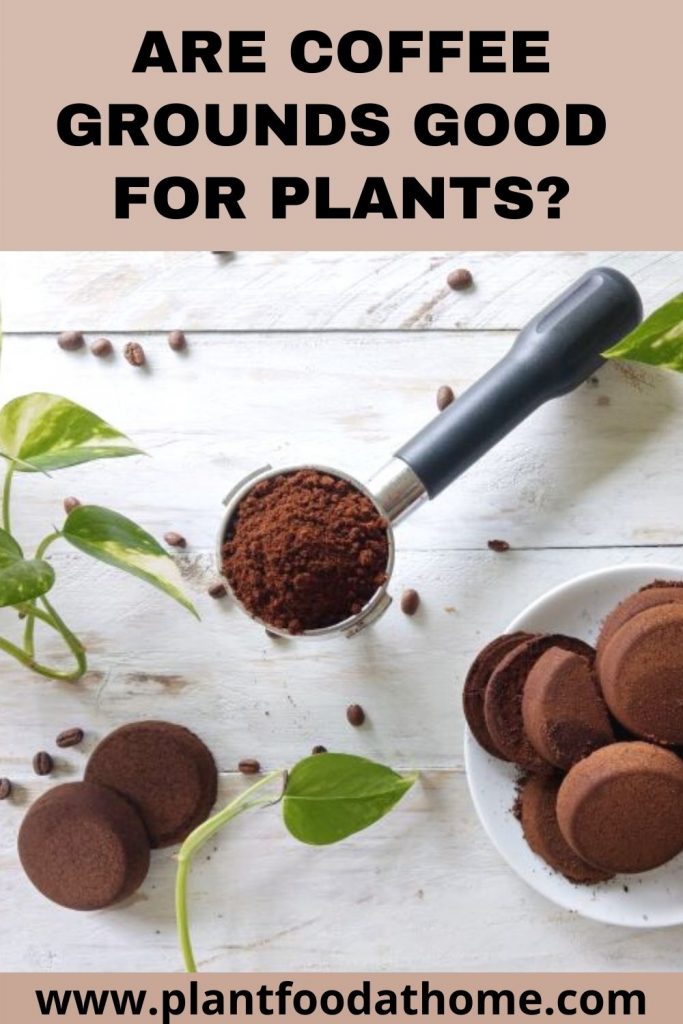As an avid coffee drinker, you always have coffee grounds handy. It seems like such a waste to throw them in the trash, but you’re not sure what else they’re good for. Could you repurpose leftover coffee grounds for your edible garden? Would your plants benefit?
Coffee grounds can be good for plants, as they have lots of nutrients that plants need. In addition, coffee grounds go great in compost, and they can improve plant soil while repelling insects like slugs. Yet the caffeine in coffee grounds means they’re not an appropriate choice for all edible plants.
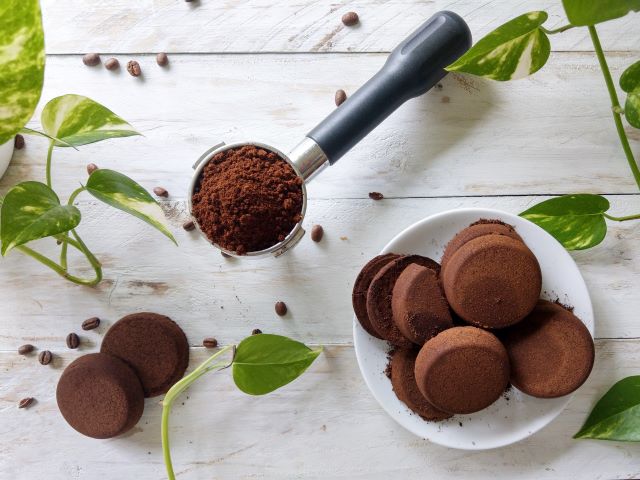
In this article, we’ll uncover the truth about coffee grounds for plants, using scientific evidence to back up all our findings. We’ll also provide some tips for using coffee grounds for your edible plants, so keep reading!
Table of Contents
Can Coffee Grounds Benefit Your Plants?
Using coffee grounds as plant fertilizer or compost might seem strange, but it’s a common practice among indoor and outdoor gardeners alike. Here are some of the perks your edible plants will get to enjoy.
Coffee Grounds Contain Plenty of Nutrients
Up to 20 macronutrients support plants biochemically, says LibreTexts. Three of the most important macronutrients are nitrogen, phosphorus, and potassium.
Nitrogen allows for synthesizing of enzymes, nucleic acids, chlorophyll, proteins, and amino acids in plants. If a plant is nitrogen-deficient, it might lack green color and will grow more slowly.
Phosphorus permits plants to share their genetic materials across generations. The nutrient also encourages starch and sugar conversion, photosynthesis, and energy transfers.
Potassium controls photosynthesis by helping plants make adenosine triphosphate or ATP. Enzymes within the plant are activated through potassium so the plant can keep producing ATP as well as starches and protein. Further, this nutrient keeps plant tissue healthy by transferring carbohydrates, water, and other nutrients.
A 2014 report from ISRN Nutrition states that coffee grounds contain not only nitrogen, phosphorus, and potassium, but other nutrients such as magnesium, iron, and calcium as well.
Magnesium is within every chlorophyll molecule, so to be deficient in this nutrient can hinder growth and plant appearance, much like nitrogen deficiencies. Iron also supports chlorophyll production while calcium keeps cell walls strong.
Coffee Grounds Improves Soil Structure
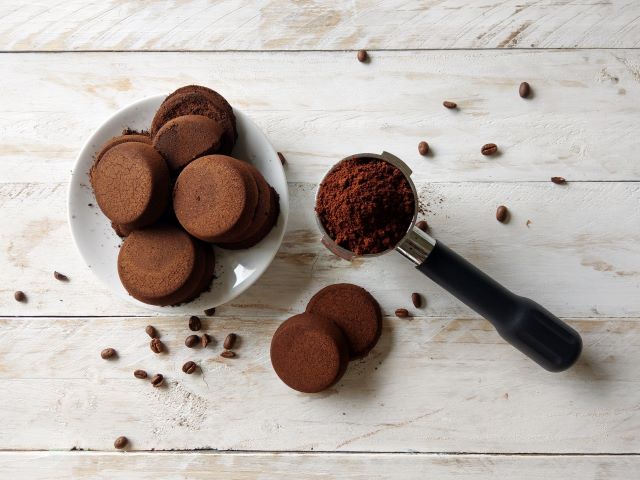
Maintaining soil structure is crucial for plant health, as your plants need aerated soil so oxygen can travel to the roots. A 2018 study from the Polish Journal of Soil Science found that adding coffee grounds to plants is for the soil’s betterment, especially for aeration.
You’ll get the best results if you combine coffee grounds with organic materials that increase aeration such as peat moss, bark mulch, sawdust, or compost.
Coffee Grounds Increases Water Retention
That’s not all coffee grounds can do for your edible plant’s soil. The grounds can improve the flow of water through the soil, says a 2019 Agricultural Water Management report. Once again, the best results will occur when coffee grounds are used in conjunction with organic materials.
Plants survive on oxygen and water. When soil becomes too compacted, even though you’re watering your plant regularly, the roots aren’t receiving enough water. This can cause the leaves to dry out, become discolored, and even shed from the plant in some instances. Your edible yield may be reduced as a result.
We do want to mention that water retention varies depending on the type of pot you choose. For instance, clay pots absorb moisture more readily so the soil won’t stay as wet.
Coffee Grounds Augments Compost
Every gardener should have a compost pile they can use as fertilizer for their plants when the occasion calls for it. Besides coffee grounds, you can save lots of household items for composting. (You can find a compost bin here.)
A healthy compost pile should have a mix of brown and green items. Some brown compostable additions you might consider are wood chips, brown paper bags (torn up, of course), pine needles, paper towel and toilet paper tubes, pinecones, fallen leaves, and newspaper (again, shredded).
For the green part of your compost pile, use disposed broccoli stalks, corn cobs, seaweed, grass clippings, healthy green weeds, plant trimmings, and peels and rinds from veggies and fruits such as citruses and melons.
Coffee grounds are a fantastic part of a green compost pile, as are the filters you use when brewing coffee, although those are technically brown.
A 2009 publication of the journal Bioresource Technology found that compost with kitchen waste such as coffee grounds had more nutrients compared to compost without the grounds.
- Related reading: 30 Surprising Things You Can Compost At Home
Coffee Grounds Repel Insects
Does growing edible plants inside or outside of your home bring with it unwanted insects? Not only can bugs flying around be a nuisance for you, but your plants as well. As critters land on the leaves and eat your plants, this can ruin your yield and sometimes even kill your plant should the infestation progress.
Coffee grounds in your plant’s soil can keep the bugs away, and that’s true as well if you spread some loose coffee grounds around the perimeter of the pot. Beetles, fruit flies, and mosquitos especially do not like coffee grounds.
It’s not a textural thing, per se. This 2007 report from the Journal of Agricultural and Food Chemistry explains that diterpenes and caffeine in coffee are lethal for these and other insect species.
Slugs and snails will also stay away from your plants if you surround your garden with coffee grounds. For these insect species, it is the texture of coffee grounds that deters them.
How to Use Coffee Grounds for Edible Plants
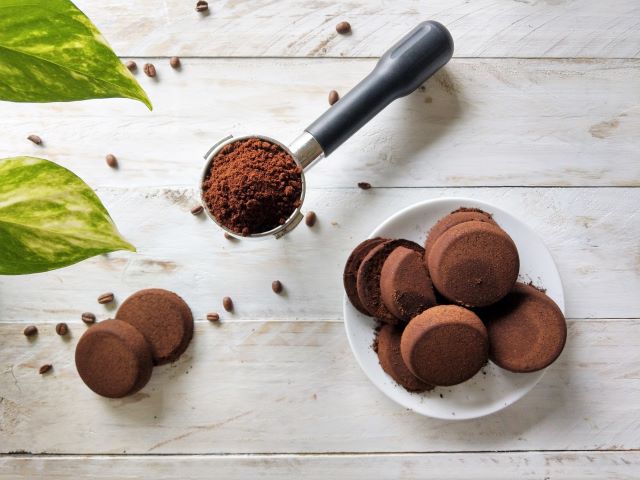
You’d like to give your coffee grounds a second life as a plant amendment, but how do you incorporate the grounds into your plant’s pot or garden soil? That’s a great question!
Morag Gamble of the Permaculture Education Institute discusses just that in a YouTube video. Gamble discourages gardeners from pouring the coffee grounds onto the top layer of the plant’s soil for several reasons.
First, the grounds don’t really incorporate well enough into the soil if you use that method. Also, your whole home or apartment will smell like coffee. In some instances, the grounds can even get moldy.
Instead, you might try these other techniques for adding coffee grounds to your plant’s pot and your garden soil.
Method 1 – Add the Coffee Grounds into the Soil Several Inches Deep
Gently remove the top few inches of soil with a shovel and then spread the coffee grounds deep into the pot or garden soil. Then you can restore the removed soil. The coffee grounds are buried enough that they shouldn’t get moldy or smell.
Method 2 – Incorporate Coffee Grounds into Your Compost Pile
Another option you can try is adding the grounds directly to your compost pile per our recommendation above. However, if this is the avenue you select, be prepared to play the waiting game.
Iowa State University’s Horticulture and Home Pest News website states that compost piles with shredded green materials will break down in about four months. Should you have not shredded the materials before adding them to the compost pile, then you could have to wait about a year before the compost would be usable in your edible garden.
Can Coffee Grounds Damage Plants?
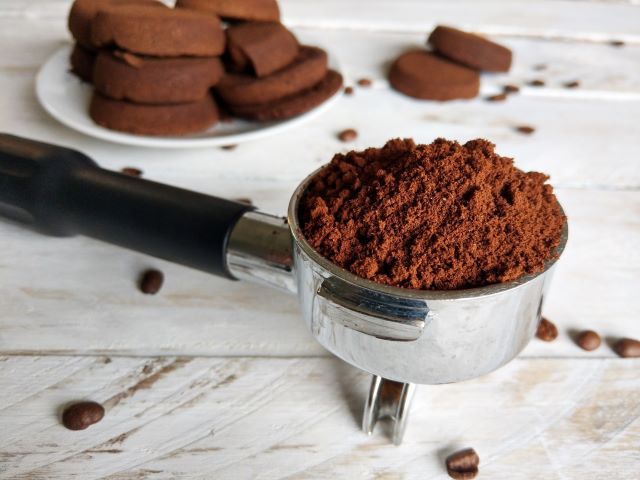
You wonder if coffee grounds can negatively affect your plants in any way. After all, aren’t coffee grounds acidic?
According to Sunset Magazine’s Starbucks coffee grounds testing, grounds from the popular coffee chain have an average pH of 6.2 to 6.8, which is only moderately acidic. Also, since the acid in coffee is water-soluble, the bulk of it is in the coffee itself and not the grounds.
Even still, while the acidity of coffee grounds might not bother an edible plant like the blueberry, for others, it could be moderately harmful.
Okay, so the acid in coffee grounds won’t hurt your plants (at least not most of them), but what about caffeine? Does that remain in the coffee grounds after all the coffee is gone?
Yes, indeed. Caffeine Informer states that the average amount of caffeine in a half tablespoon of used coffee grounds is 41 milligrams.
Is that much caffeine going to encourage faster growth in edible plants or slower growth?
More than likely, it would be the latter. Educational resource UC ANR published an article in 2019 that stated the following: “Caffeine reduces competition from other plants by suppressing their growth. Thus, there is a possibility that coffee grounds can suppress the growth of plants we want to grow and not just the weeds that we don’t want to grow.”
Diluting coffee with water can reduce its caffeine content, but that says nothing of the coffee grounds. You can always cut down on the amount of coffee grounds you use in your edible plant’s soil, but that in turn reduces the above benefits.
Composting coffee grounds might lessen the effects of caffeine depending on what else you add to the compost pile.
My Preferred Method for Using Coffee Ground
Personally, I compost my coffee grounds. I do this by simply adding them to my compost pile and then once the compost is ready, I use it directly on my edible garden by top dressing the soil. And my plants are thriving!
I usually add compost to my garden at the beginning of each new planting season to help feed the soil. A layer of 1-2 inches is usually enough for my garden, however, if your soil needs more rejuvenation, then you could add additional compost.
Conclusion
Coffee grounds are full of macronutrients that healthy plants need. When combined with organic materials, the coffee grounds can also improve soil aeration and water retention. Composting your coffee grounds before using them on your edible plants is my preferred method.
- How to Start a Vegetable Garden: A Beginners Guide
- Milk Spray Recipe For Powdery Mildew (Natural Fungicide for Plants)
- Best Organic Mulch for the Garden and Natural Mulch Ideas
- Why Does Mulch Smell Bad? (And How to Fix It)
- Natural and Organic Vegetable Garden Weed Control Methods
- Why Blueberry Bush Flowers But No Fruit (With Solutions)
- Why Are My Blueberries So Small? Causes And Solutions
